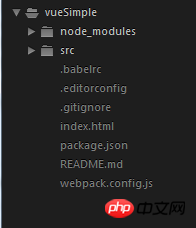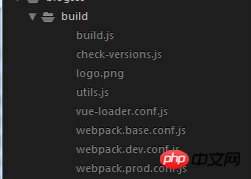
本文章适合初学者学习,如有错请提出。近期对vue比较感兴趣,所以准备用vue写一个blog。早期先对vue脚手架了解一下,对于新手官网建议先不用vue-cli,但我觉得如果没有任何的依据凭自己写一个项目(包括webpack的配置等)这无疑是浪费时间的而且都最后还是是而非的。所以我觉得完全可以用脚手架建一个webpack项目,然后我们可以具体对应它生成的文件学习(当然这只是我的学习方法,我认为这样比较好学,但不一定人人都是这样的)。
在学习的过程中发现网上许多的简介都已经过期(vue发展的过快了吧。。。。),所以我结合自己的项目和网上的资料备注一下,希望和其他的人一起讨论。这个适合的版本为:nodejs(6.10.2)、vue(2.5.2)、vue-router(3.0.1)和webpack(3.6.0)的。适合的环境为windows的,其他的系统我也不知道可不可以用。
一、vue-cli安装、webpack项目新建
1、默认电脑已经安装了node,不会的请百度然后先安装nodejs。
2、安装好nodejs之后,全局安装vue-cli:npm install -g vue-cli。
3、新建webpack项目:vue init webpack projectname(这是比较完整的,我们学习用这个比较好)、vue init webpack-simple projectname(简易版的)。
注意:projectname项目名不能用中文。
4、“vue init webpack-simple projectname”创建新项目的目录结构:
生成新项目时并没有安装依赖,需要进入新的项目安装依赖:cd projectname -> npm install。
新建项目时,会需要填一些东西,但如果你都不想填也无所谓,全部默认、全部yes都行:
(1)、Project name:——项目名称
(2)、Project description:——项目描述
(3)、Author:——作者
(4)、Vue build:——构建模式,一般默认选择第一种
(5)、Install vue-router?:——是否安装引入vue-router,这里选是,vue-router是路由组件,后面构建项目会用到
(6)、Use ESLint to lint your code?:——eslint的格式验证非常严格,多一个空格少一个空格都会报错。个人觉得如果是平时练习的话可以选yes因为这个可以规范自己js代码的书写规范。但在实际开发项目中不建议使用,会影响开发效率。
(7)、Setup unit tests with Karma + Mocha 以及Setup e2e tests with Nightwatch这两个是测试,可以不用安装。

“vue init webpack projectname”创建新项目的目录结构:


二、build目录下配置文件之check-versions.js
这个文件并不是十分重要,只要稍微了解就行了。
/**
* 验证版本
*/
'use strict'
//chalk是一个颜色插件。可以通过
const chalk = require('chalk')
//semver一个版本控制插件
const semver = require('semver')
const packageConfig = require('../package.json')
//shelljss是nodejs对与多进程的支持,是对于child_process封装
const shell = require('shelljs')
function exec (cmd) {
return require('child_process').execSync(cmd).toString().trim()
}
const versionRequirements = [
{//对应node的版本
name: 'node',
//当前环境版本,semver.clean把当前环境版本信息转化规定格式,也是' =v1.2.3 '->'1.2.3'
currentVersion: semver.clean(process.version),
//要求版本,对应package.json的engines所配置的信息
versionRequirement: packageConfig.engines.node
}
]
//npm环境中
if (shell.which('npm')) {
versionRequirements.push({
name: 'npm',
//执行方法得到版本号
currentVersion: exec('npm --version'),
versionRequirement: packageConfig.engines.npm
})
}
module.exports = function () {
const warnings = []
for (let i = 0; i < versionRequirements.length; i++) {
const mod = versionRequirements[i]
//如果版本号不符合package.json文件中指定的版本号,就执行下面的代码
if (!semver.satisfies(mod.currentVersion, mod.versionRequirement)) {
warnings.push(mod.name + ': ' +
chalk.red(mod.currentVersion) + ' should be ' +
chalk.green(mod.versionRequirement)
)
}
}
if (warnings.length) {
console.log('')
console.log(chalk.yellow('To use this template, you must update following to modules:'))
console.log()
for (let i = 0; i < warnings.length; i++) {
const warning = warnings[i]
console.log(' ' + warning)
}
console.log()
process.exit(1)
}
}三、build目录下配置文件之utils.js
这个文件主要用于处理有关于css方面的,主要对后面vue-loader.conf.js文件有关系,对webpack配置loaders方面也有影响。
/**
* webpack开发环境:主要用来处理css-loader和vue-style-loader
*/
'use strict'
const path = require('path')
const config = require('../config')
//引入extract-text-webpack-plugin插件,用来将css提取到单独的css文件中
const ExtractTextPlugin = require('extract-text-webpack-plugin')
const packageConfig = require('../package.json')
exports.assetsPath = function (_path) {
//process.env.NODE_ENV在bulid.js中定义
//如果为生产环境assetsSubDirectory为“static”,否则也为“static”
//config.build.assetsSubDirectory与config.dev.assetsSubDirectory都在config/index中定义
const assetsSubDirectory = process.env.NODE_ENV === 'production'
? config.build.assetsSubDirectory
: config.dev.assetsSubDirectory
//path.join和path.posix.join区别前者返回完整路径,后者返回完整路径的相对路径
//例:path.join是E:/shishans/blogsss/static,path.posix.join是static
return path.posix.join(assetsSubDirectory, _path)
}
exports.cssLoaders = function (options) {
options = options || {}
//css-loader的基本配置
const cssLoader = {
loader: 'css-loader',
options: {
//option用于配置loder的
//是否开启cssMap,默认是false
//一般我们会压缩js或者css以节省宽带,但在开发压缩就很难调试
//所以用sourceMap进行关联,给出对应的sourceMap文件
sourceMap: options.sourceMap
}
}
const postcssLoader = {
loader: 'postcss-loader',
options: {
sourceMap: options.sourceMap
}
}
// generate loader string to be used with extract text plugin
function generateLoaders (loader, loaderOptions) {
//将上面的基础配置放到一个数据中
const loaders = options.usePostCSS ? [cssLoader, postcssLoader] : [cssLoader]
//如果该函数传递了单独的loder就加入到loaders数组中例如:sass或者less之类的
if (loader) {
loaders.push({
//加载对应的loader
loader: loader + '-loader',
//es6方法Object.assign:主要用于合并对象的,浅拷贝
options: Object.assign({}, loaderOptions, {
sourceMap: options.sourceMap
})
})
}
// Extract CSS when that option is specified
// (which is the case during production build)
// extract自定义属性,用ExtractTextPlugin.extract控制是否把文件单独提取
// true:单独提取,false表示不提取
if (options.extract) {
return ExtractTextPlugin.extract({
use: loaders,
fallback: 'vue-style-loader'
})
} else {
//[].concat()方法用于连接数组
return ['vue-style-loader'].concat(loaders)
}
}
// https://vue-loader.vuejs.org/en/configurations/extract-css.html
return {
css: generateLoaders(),//返回[cssLoader, vue-style-loader]
postcss: generateLoaders(),//返回[cssLoader, vue-style-loader]
less: generateLoaders('less'),//返回[cssLoader, vue-style-loader, less]
sass: generateLoaders('sass', { indentedSyntax: true }),
scss: generateLoaders('sass'),
stylus: generateLoaders('stylus'),
styl: generateLoaders('stylus')
}
}
// Generate loaders for standalone style files (outside of .vue)
// 这个方法主要处理import这种方式导入的文件类型的打包
exports.styleLoaders = function (options) {
const output = []
const loaders = exports.cssLoaders(options)
for (const extension in loaders) {
const loader = loaders[extension]
output.push({
test: new RegExp('\\.' + extension + '$'),
use: loader
})
}
return output
}
//用于返回脚手架错误的函数
exports.createNotifierCallback = () => {
//使用node-notifier来发送桌面消息,包括应用状态改变以及错误信息
const notifier = require('node-notifier')
return (severity, errors) => {
if (severity !== 'error') return
const error = errors[0]
const filename = error.file && error.file.split('!').pop()
notifier.notify({
title: packageConfig.name,
message: severity + ': ' + error.name,
subtitle: filename || '',
icon: path.join(dirname, 'logo.png')
})
}
}四、build目录下配置文件之webpack.base.conf.js
从这个文件开始,webpack配置文件正式开始,前面的相当于是这个文件参数般的存在。而实际上这个也不是正式会运行的配置文件。一个项目有2中情况:开发环境和生成环境。这2中环境一些方面的配置是不一样的,比如在生产环境我们会对js和css进行压缩以减少宽带。这个文件实际上是这2中环境通用的配置。下面的webpack.dev.conf.js文件(开发环境)、
webpack.prod.conf.js(生产环境),这2个文件才是实际环境运行使用的配置文件。
/**
* webpack开发环境和生成环境通用的配置
*/
'use strict'
const path = require('path')
const utils = require('./utils')
const config = require('../config')
const vueLoaderConfig = require('./vue-loader.conf')
//获取对应文件路径的函数
//因为该文件是在项目的二级文件build下,所以要加上../这样才能找到像src这样的目录
function resolve (dir) {
//join方法用于将多个字符串结合成一个路径字符串
//path在node中会经常用到可以仔细了解一下path的各种方法
//dirname:获取当前文件所在目录的完整绝对路径
return path.join(dirname, '..', dir)
}
//eslint用来检查我们写的js代码是否满足指定的规则
const createLintingRule = () => ({
test: /\.(js|vue)$/,
loader: 'eslint-loader',
enforce: 'pre',
include: [resolve('src'), resolve('test')],
options: {
formatter: require('eslint-friendly-formatter'),
emitWarning: !config.dev.showEslintErrorsInOverlay
}
})
module.exports = {
context: path.resolve(dirname, '../'),
entry: {
//入口文件是src下的main.js
app: './src/main.js'
},
output: {
path: config.build.assetsRoot,
filename: '[name].js',
publicPath: process.env.NODE_ENV === 'production'
? config.build.assetsPublicPath
: config.dev.assetsPublicPath
},
resolve: {
//自动解析确定的扩展,在引入模块时不带扩展名
//例如:import somejs from "@/some"
extensions: ['.js', '.vue', '.json'],
alias: {
// 后面的$符号指精确匹配
// 也就是说只能使用 import vuejs from "vue" 这样的方式导入vue.esm.js文件
'vue$': 'vue/dist/vue.esm.js',
// resolve('src') 其实在这里就是项目根目录中的src目录
// 例如引用src目录下的some.js方法:import somejs from "@/some.js"
// 用@来代替../src
'@': resolve('src'),
}
},
module: {
rules: [
...(config.dev.useEslint ? [createLintingRule()] : []),
{
test: /\.vue$/,
loader: 'vue-loader',
options: vueLoaderConfig
},
{
test: /\.js$/,
loader: 'babel-loader',
include: [resolve('src'), resolve('test'), resolve('node_modules/webpack-dev-server/client')]
},
{
test: /\.(png|jpe?g|gif|svg)(\?.*)?$/,
loader: 'url-loader',
options: {
limit: 10000,
name: utils.assetsPath('img/[name].[hash:7].[ext]')
}
},
{
test: /\.(mp4|webm|ogg|mp3|wav|flac|aac)(\?.*)?$/,
loader: 'url-loader',
options: {
limit: 10000,
name: utils.assetsPath('media/[name].[hash:7].[ext]')
}
},
{
test: /\.(woff2?|eot|ttf|otf)(\?.*)?$/,
loader: 'url-loader',
options: {
limit: 10000,
name: utils.assetsPath('fonts/[name].[hash:7].[ext]')
}
}
]
},
node: {
// prevent webpack from injecting useless setImmediate polyfill because Vue
// source contains it (although only uses it if it's native).
setImmediate: false,
// prevent webpack from injecting mocks to Node native modules
// that does not make sense for the client
dgram: 'empty',
fs: 'empty',
net: 'empty',
tls: 'empty',
child_process: 'empty'
}
}五、build目录下配置文件之webpack.dev.conf.js
webpack.prod.conf.js也差不多。这2者之间的差别以后再讨论。
/**
* 此文件用于开发环境下的webpack配置
* 就本项目执行npm run dev 和 npm run start都会用到这个文件的配置
* 具体可以参考JavaScript中"scripts"的配置
*/
'use strict'
const utils = require('./utils')
const webpack = require('webpack')
const config = require('../config')
const merge = require('webpack-merge')
const path = require('path')
const baseWebpackConfig = require('./webpack.base.conf')
const CopyWebpackPlugin = require('copy-webpack-plugin')
//生成html文件
const HtmlWebpackPlugin = require('html-webpack-plugin')
//friendly-errors-webpack-plugin:把webpack的错误和日志搜集起来展现给用户
const FriendlyErrorsPlugin = require('friendly-errors-webpack-plugin')
const portfinder = require('portfinder')
const HOST = process.env.HOST
const PORT = process.env.PORT && Number(process.env.PORT)
const devWebpackConfig = merge(baseWebpackConfig, {
module: {
rules: utils.styleLoaders({ sourceMap: config.dev.cssSourceMap, usePostCSS: true })
},
// cheap-module-eval-source-map is faster for development
// devtool是开发工具选项,用来指定如何生成sourcemap文件,cheap-module-eval-source-map此款soucemap文件性价比最高
// 生产环境:#source-map
// 开发环境:#cheap-module-eval-source-map 编译消耗小
devtool: config.dev.devtool,
// these devServer options should be customized in /config/index.js
devServer: {
clientLogLevel: 'warning',
historyApiFallback: {
rewrites: [
{ from: /.*/, to: path.posix.join(config.dev.assetsPublicPath, 'index.html') },
],
},
hot: true,
contentBase: false, // since we use CopyWebpackPlugin.
compress: true,
host: HOST || config.dev.host,
port: PORT || config.dev.port,
open: config.dev.autoOpenBrowser,
overlay: config.dev.errorOverlay
? { warnings: false, errors: true }
: false,
publicPath: config.dev.assetsPublicPath,
proxy: config.dev.proxyTable,
quiet: true, // necessary for FriendlyErrorsPlugin
watchOptions: {
poll: config.dev.poll,
}
},
plugins: [
// DefinePlugin内置webpack插件,专门用来定义全局变量的
// 下面定义一个全局变量 process.env 并且值是如下
new webpack.DefinePlugin({
'process.env': require('../config/dev.env')
}),
// 这个插件帮助你实现无刷新加载,关于内部实现原理
new webpack.HotModuleReplacementPlugin(),
new webpack.NamedModulesPlugin(), // HMR shows correct file names in console on update.
new webpack.NoEmitOnErrorsPlugin(),
// https://github.com/ampedandwired/html-webpack-plugin
new HtmlWebpackPlugin({
filename: 'index.html',
template: 'index.html',
inject: true
}),
// copy custom static assets
new CopyWebpackPlugin([
{
from: path.resolve(dirname, '../static'),
to: config.dev.assetsSubDirectory,
ignore: ['.*']
}
])
]
})
module.exports = new Promise((resolve, reject) => {
portfinder.basePort = process.env.PORT || config.dev.port
portfinder.getPort((err, port) => {
if (err) {
reject(err)
} else {
// publish the new Port, necessary for e2e tests
process.env.PORT = port
// add port to devServer config
devWebpackConfig.devServer.port = port
// Add FriendlyErrorsPlugin
devWebpackConfig.plugins.push(new FriendlyErrorsPlugin({
compilationSuccessInfo: {
messages: [`Your application is running here: http://${devWebpackConfig.devServer.host}:${port}`],
},
onErrors: config.dev.notifyOnErrors
? utils.createNotifierCallback()
: undefined
}))
resolve(devWebpackConfig)
}
})
})六、config目录下之index.js
这个文件配置了一些全局属性,分别dev和build用于区别开发环境和生产环境不同的地方。
相信看了本文案例你已经掌握了方法,更多精彩请关注php中文网其它相关文章!
推荐阅读:
Das obige ist der detaillierte Inhalt vonDetaillierte Erläuterung der Schritte der vue-cli-Konfigurationsdatei. Für weitere Informationen folgen Sie bitte anderen verwandten Artikeln auf der PHP chinesischen Website!
 Einführung in PHP-Konfigurationsdateien
Einführung in PHP-Konfigurationsdateien
 Was tun, wenn der Computer keinen Ton hat?
Was tun, wenn der Computer keinen Ton hat?
 Was sind die Java-Testtools?
Was sind die Java-Testtools?
 Der Unterschied zwischen SQL Server und MySQL
Der Unterschied zwischen SQL Server und MySQL
 Einführung in die Gründe, warum der Remote-Desktop keine Verbindung herstellen kann
Einführung in die Gründe, warum der Remote-Desktop keine Verbindung herstellen kann
 Einführung in den PHP-Server
Einführung in den PHP-Server
 Was sind die Oracle-Indextypen?
Was sind die Oracle-Indextypen?
 Was passiert, wenn phpmyadmin nicht darauf zugreifen kann?
Was passiert, wenn phpmyadmin nicht darauf zugreifen kann?




